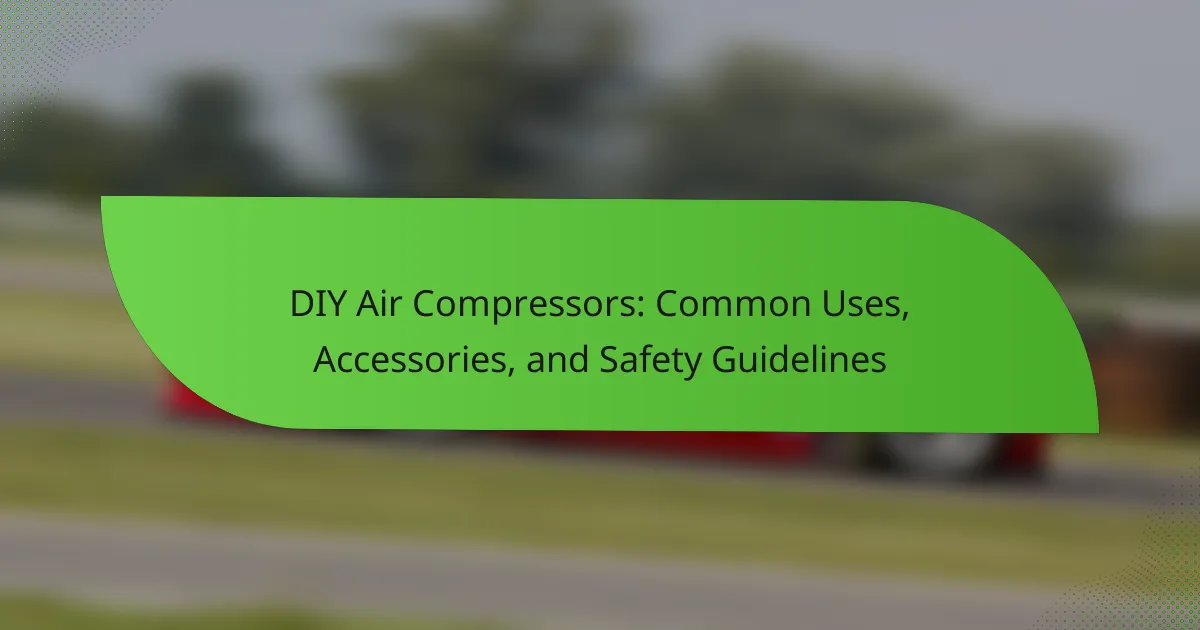DIY air compressors are devices designed to compress air for various applications, often constructed from accessible components like modified refrigerators or old air conditioning units. This article explores essential factors for selecting a DIY air compressor, including pressure output measured in PSI, airflow rate expressed in CFM, and tank size. Additionally, it emphasizes the importance of maintenance, such as checking oil levels, cleaning air filters, and draining moisture to ensure optimal performance and longevity. Understanding these elements will help users effectively utilize DIY air compressors for tasks like inflating tires, powering pneumatic tools, and spray painting.

What are DIY Air Compressors?
DIY air compressors are devices that compress air for various applications. They are often built from readily available components. Common DIY designs include using modified refrigerators or old air conditioning units. These compressors can be used for inflating tires, powering pneumatic tools, or spray painting. The efficiency and capacity depend on the components used in the build. DIY air compressors can be tailored to specific needs, such as pressure and airflow requirements. Many enthusiasts share plans and tutorials online for building these compressors. The popularity of DIY air compressors has grown due to their cost-effectiveness and customization options.
How do DIY Air Compressors operate?
DIY air compressors operate by converting power into potential energy stored in pressurized air. They typically use a motor to drive a piston or a rotary screw mechanism. This action compresses air and forces it into a storage tank. The compressed air can then be released through a valve for various applications.
When the motor runs, it creates a vacuum that draws in air. The piston or screw compresses this air, increasing its pressure. The air is stored in the tank until needed. The pressure is measured in PSI (pounds per square inch), which indicates the force of the compressed air.
The efficiency of DIY air compressors depends on several factors, including the motor’s power and the tank’s size. Larger tanks can store more air, allowing for longer use without needing to refill. Understanding the CFM (cubic feet per minute) rating is also essential, as it indicates the air flow rate. This determines how quickly tools can operate.
In summary, DIY air compressors function by using a motor to compress air, store it in a tank, and release it for various uses, with efficiency influenced by PSI, CFM, and tank size.
What are the key components of a DIY Air Compressor?
The key components of a DIY air compressor include a motor, a compressor pump, a tank, and a pressure regulator. The motor powers the compressor pump, which compresses air. The tank stores the compressed air for later use. A pressure regulator controls the air pressure output. Additionally, an air filter and hoses are essential for air intake and distribution. These components work together to create a functional air compressor system.
How does each component contribute to the compressor’s functionality?
The compressor consists of several key components that each play a vital role in its functionality. The motor powers the compressor, converting electrical energy into mechanical energy. The pump compresses air, increasing its pressure for various applications. The tank stores the compressed air, providing a reserve for consistent pressure. The pressure switch regulates the compressor’s operation by turning it on and off at preset pressure levels. The regulator controls the output pressure, ensuring it meets the requirements of connected tools. The intake filter prevents contaminants from entering the compressor, protecting internal components. Lastly, the discharge valve allows for the release of compressed air, facilitating the operation of pneumatic tools. Each component works together to ensure efficient air compression and delivery.
Why are PSI Ratings important in DIY Air Compressors?
PSI ratings are crucial in DIY air compressors because they indicate the pressure output of the compressor. This pressure determines the tools and applications the compressor can effectively support. For instance, standard pneumatic tools typically require a minimum PSI to operate efficiently. A higher PSI rating allows for more demanding tasks, such as spray painting or inflating heavy-duty tires. Conversely, a lower PSI may be sufficient for lighter tasks like inflating sports equipment. Understanding PSI ratings ensures that users select a compressor that meets their specific needs. Accurate PSI ratings also prevent damage to tools and improve overall performance.
What does PSI stand for and how is it measured?
PSI stands for Pounds per Square Inch. It is a unit of pressure used to measure the force exerted by air in a given area. PSI is commonly used in various applications, including tire pressure and air compressors. To measure PSI, a pressure gauge is typically used. This gauge provides a reading of the air pressure in the system. Accurate readings are crucial for ensuring optimal performance and safety in air compressors.
How do different PSI ratings impact performance?
Different PSI ratings significantly impact the performance of air compressors. PSI, or pounds per square inch, measures the pressure of the air produced. Higher PSI ratings allow for more powerful airflow, which is essential for heavy-duty tasks. For instance, a compressor with a PSI rating of 90 can effectively power tools like nail guns and spray guns. Conversely, a lower PSI rating, such as 30, limits the compressor’s ability to operate demanding tools efficiently. This means that tasks requiring high pressure may take longer or be impossible with insufficient PSI. Additionally, tools designed for specific PSI ranges perform best when supplied with the appropriate pressure. Therefore, selecting the correct PSI rating is crucial for optimal performance in DIY projects.
What are CFM Requirements in the context of DIY Air Compressors?
CFM requirements in the context of DIY air compressors refer to the cubic feet per minute measurement of airflow. This metric indicates the volume of air an air compressor can deliver in one minute. Different tools and applications have specific CFM requirements. For example, a nail gun typically requires 2 to 4 CFM, while a spray painter may need 8 to 12 CFM. Matching the compressor’s CFM output to the tool’s requirement ensures efficient operation. Insufficient CFM can lead to reduced performance or tool malfunction. Therefore, understanding CFM is crucial for selecting the right air compressor for DIY projects.
What does CFM mean and why is it crucial?
CFM stands for Cubic Feet per Minute. It measures the volume of air an air compressor can deliver in one minute. CFM is crucial because it determines the compressor’s ability to power tools. Higher CFM ratings allow for more demanding tools to operate effectively. For example, a nail gun may require 2-4 CFM, while a spray gun may need 10 CFM. Insufficient CFM can lead to tool inefficiency or failure. Thus, understanding CFM is essential for selecting the right air compressor for specific tasks.
How do you determine the CFM needed for specific tools?
To determine the CFM needed for specific tools, first identify the tool’s requirements. Each air tool has a specified CFM rating for optimal performance. This rating indicates the volume of air the tool needs to operate effectively. For instance, a nail gun may require 2-4 CFM, while a spray gun might need 10-15 CFM.
Consult the manufacturer’s specifications for each tool. These specifications typically list the required CFM at a given PSI. Ensure that your air compressor can meet or exceed the CFM rating of the tool.
If multiple tools are used simultaneously, add their CFM requirements together. This ensures that the compressor can supply enough air for all tools in use.
Finally, consider using an air compressor with a higher CFM rating than needed. This provides a buffer for peak demands and prolongs the compressor’s lifespan.
How do Tank Sizes affect DIY Air Compressors?
Tank sizes significantly impact the performance of DIY air compressors. A larger tank can store more compressed air, allowing for longer usage periods without needing to refill. This is particularly beneficial for tasks that require continuous airflow, such as spray painting or powering pneumatic tools. Conversely, smaller tanks may lead to rapid depletion of air, necessitating frequent cycling of the compressor.
For instance, a 20-gallon tank provides a greater air reserve compared to a 5-gallon tank, which results in less downtime during operation. Additionally, tank size influences the compressor’s recovery time. A larger tank typically has a slower recovery rate but maintains pressure more effectively. In contrast, smaller tanks can recover quickly but may struggle to maintain consistent pressure during demanding tasks.
Overall, choosing the appropriate tank size is crucial for optimizing the efficiency and effectiveness of DIY air compressors.
What are the common tank sizes available for DIY Air Compressors?
Common tank sizes for DIY air compressors include 1 gallon, 2.5 gallons, 5 gallons, 10 gallons, and 20 gallons. These sizes cater to various applications and user needs. Smaller tanks, like 1 and 2.5 gallons, are ideal for light tasks. Medium-sized tanks, such as 5 and 10 gallons, support moderate usage. Larger tanks, like 20 gallons, are suitable for more demanding projects. Each size balances portability and air supply duration. The choice of tank size affects the compressor’s efficiency and performance for specific tasks.
How does tank size influence compressor efficiency and usage?
Tank size directly influences compressor efficiency and usage by affecting the air supply and recovery time. A larger tank stores more compressed air, allowing the compressor to run less frequently. This leads to reduced wear on the motor and improved overall efficiency. For instance, a 60-gallon tank can provide air for longer periods without the need for the compressor to cycle on and off. Conversely, smaller tanks may require the compressor to operate more continuously, which can increase energy consumption and reduce lifespan. Studies show that compressors with larger tanks can maintain consistent pressure levels, enhancing performance in demanding applications.

What factors should you consider when selecting a DIY Air Compressor?
When selecting a DIY air compressor, consider the pressure output, measured in PSI. The PSI rating determines the compressor’s ability to power tools effectively. Look for a compressor that meets the requirements of your tools. Next, evaluate the air flow rate, expressed in CFM. CFM indicates how much air the compressor can deliver, impacting tool performance. Ensure the CFM rating aligns with your tools’ needs for efficient operation.
Tank size is another crucial factor. A larger tank can store more air, allowing for longer tool use without interruption. Consider portability if you plan to move the compressor frequently. Lightweight models are easier to transport. Lastly, assess the noise level, as some compressors operate quietly while others can be quite loud. Selecting a compressor that balances these factors will enhance your DIY projects.
How do PSI, CFM, and tank size work together?
PSI, CFM, and tank size work together to determine an air compressor’s efficiency and suitability for specific tasks. PSI, or pounds per square inch, measures the air pressure produced by the compressor. Higher PSI ratings indicate stronger pressure, which is essential for certain tools like nail guns or paint sprayers. CFM, or cubic feet per minute, measures the airflow rate. A higher CFM indicates that the compressor can deliver more air, which is necessary for continuous operation of air tools.
Tank size affects how long the compressor can run before needing to refill. A larger tank stores more compressed air, allowing for longer usage without interruption. For instance, a tool requiring 4 CFM at 90 PSI will need a compressor that can sustain that CFM at the specified PSI. If the tank is too small, the compressor may frequently cycle on and off, reducing efficiency and increasing wear.
In summary, PSI provides the necessary pressure, CFM ensures adequate airflow, and tank size determines operational duration. Together, they create a balanced system that meets the demands of various air tools.
What is the ideal balance between PSI, CFM, and tank size?
The ideal balance between PSI, CFM, and tank size depends on the specific application. Generally, a PSI of 90-120 is suitable for most tools. A CFM rating of 4-6 is often adequate for common air tools. Tank size should be at least 2-6 gallons for portability and efficiency. For continuous use tools, larger tanks (10-20 gallons) are recommended. This balance ensures consistent airflow and pressure for optimal tool performance. Proper matching of these attributes prevents issues like pressure drops and inadequate airflow during operation.
What safety precautions should be taken with DIY Air Compressors?
Use proper safety precautions when working with DIY air compressors. Always wear safety goggles to protect your eyes from debris. Ensure the compressor is placed on a stable surface to prevent tipping. Regularly inspect hoses and connections for leaks or damage. Avoid exceeding the manufacturer’s recommended PSI limits to prevent explosions. Keep the compressor in a well-ventilated area to avoid overheating. Disconnect power when not in use to prevent accidental activation. Follow these guidelines to minimize risks associated with DIY air compressors.
What are the common risks associated with DIY Air Compressors?
Common risks associated with DIY air compressors include explosion hazards, improper pressure regulation, and electrical malfunctions. Explosions can occur if the air tank is over-pressurized or if it has structural defects. Improper pressure regulation can lead to equipment damage or personal injury. Electrical malfunctions may arise from faulty wiring or inadequate power supply, increasing the risk of shocks or fires. Additionally, there are risks of noise-induced hearing loss due to high decibel levels. Lastly, inadequate ventilation can lead to the accumulation of harmful fumes, posing health risks.
How can you mitigate these risks during operation?
To mitigate risks during the operation of DIY air compressors, implement safety measures. Regularly inspect the compressor for leaks or damage. Ensure that the pressure relief valve functions correctly to prevent over-pressurization. Use appropriate personal protective equipment, such as goggles and gloves, to protect against debris and noise. Maintain a safe distance from flammable materials while operating the compressor. Follow the manufacturer’s guidelines for proper usage and maintenance. Keeping the workspace well-ventilated reduces the risk of harmful fumes. Training users on safe operation practices minimizes human error. These measures collectively enhance safety and reduce the likelihood of accidents.

What are some tips for maintaining your DIY Air Compressor?
Regularly check the oil level in your DIY air compressor. Low oil can lead to overheating and damage. Change the oil according to the manufacturer’s recommendations. Clean or replace the air filter frequently to ensure optimal airflow. Inspect and tighten all fittings and connections to prevent leaks. Drain the moisture from the tank after each use to avoid rust. Store the compressor in a dry location to protect it from environmental factors. Finally, run the compressor periodically to keep components in working order. These maintenance tips help extend the lifespan and efficiency of your DIY air compressor.
How can regular maintenance extend the life of your compressor?
Regular maintenance can significantly extend the life of your compressor. Routine checks ensure that all components are functioning correctly. This includes inspecting belts, filters, and oil levels. Clean filters improve airflow and efficiency. Regular oil changes prevent wear on moving parts. Tightening loose connections reduces the risk of leaks. Monitoring pressure levels helps avoid overworking the compressor. Studies show that well-maintained compressors can last up to 50% longer than those neglected. Proper maintenance not only prolongs lifespan but also enhances performance and reliability.
What specific maintenance tasks should you perform regularly?
Regular maintenance tasks for air compressors include checking and changing the oil. This ensures proper lubrication and prevents overheating. Additionally, you should inspect and clean the air filter. A clean filter improves airflow and efficiency. Draining the tank of moisture is crucial to prevent rust and corrosion. Tightening loose fittings helps maintain optimal pressure and performance. Inspecting hoses and connections for wear can prevent leaks. Finally, checking the pressure gauge ensures accurate readings for safe operation. These tasks enhance the lifespan and reliability of the air compressor.
What troubleshooting tips can help with common issues in DIY Air Compressors?
Check for power supply issues if the air compressor fails to start. Ensure the outlet is functioning and the power cord is intact. Inspect the pressure switch for proper operation. A faulty switch can prevent the compressor from turning on. Examine the air filter for clogs. A dirty filter restricts airflow and reduces efficiency. Clean or replace the filter as needed. Verify that the tank is not leaking. Use soapy water to check for bubbles around fittings and connections. Address any leaks immediately to maintain pressure. Check the safety valve for proper function. A malfunctioning valve can cause pressure loss. Lastly, monitor the compressor for unusual noises. Strange sounds may indicate mechanical issues requiring professional inspection.
What are the signs of a malfunctioning compressor?
Signs of a malfunctioning compressor include unusual noises, such as grinding or hissing sounds. These noises often indicate internal issues or air leaks. Additionally, a compressor may show signs of overheating, which can lead to reduced performance. If the compressor frequently cycles on and off, it indicates a problem with pressure regulation. Another sign is a noticeable decrease in air pressure output, affecting tool performance. Lastly, if there is visible oil leakage, it suggests seal or gasket failure. These signs collectively point to potential mechanical failures that require attention.
How can you resolve common air compressor problems?
To resolve common air compressor problems, first identify the specific issue. For a compressor that won’t start, check the power supply and ensure the unit is plugged in. If the compressor runs but doesn’t build pressure, inspect for leaks in the hoses or fittings. Tighten or replace any damaged components. If the compressor is excessively noisy, check for loose parts or worn bearings. Lubricate moving parts as needed. For overheating issues, clean the air filter and ensure proper ventilation around the unit. Lastly, if the pressure switch is malfunctioning, consider replacing it to restore function. These steps address the most frequent air compressor issues effectively.
DIY air compressors are devices that compress air for various applications, often constructed from readily available components. This article provides a comprehensive overview of their operation, key components, and the importance of PSI ratings, CFM requirements, and tank sizes in selecting the right compressor for specific tasks. It covers how these attributes interact to influence performance and efficiency, as well as essential safety precautions and maintenance tips to prolong the lifespan of DIY air compressors. Understanding these factors is crucial for optimizing the use of air compressors in various DIY projects.



